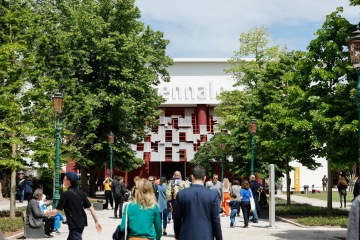
Top Picks from the 2023 Venice Biennale: The Laboratory of the Future
Leslie Lokko looks towards a “more equitable and optimistic future” as the curator of this year's Venice Architecture Biennale entitled the "Laboratory of the Future."
reSITE attended the media preview for the exhibition, which runs from May 20 to November 26, and found the central themes woven between the exhibition to answer to the curation with a new level of self-awareness and introspection.The 63 national pavilions along with this year’s 89 Arsenale participants used their respective platforms to make statements on themes like decolonization, climate resiliency, and accessibility that seemed to answer Lokko’s curation that positions the African continent as a driving force shaping the future. Her effort catapulted underrepresented voices into recognition and balanced dialogues that aim to broaden the very definition of who or what our environments–urban or not–are built for.
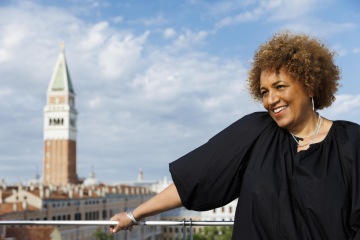
The 18th edition of the event deconstructs the heart of architecture itself. Centered on responding to the questions of the future, the design featured at the Biennale expands the perspectives that challenge what we consider architecture to be. Lokko's curation confronts how art shapes a society in change, ultimately capturing the present zeitgeist. This year's Biennale leans heavily into climate responsible technologies and how that goes hand-in-hand with both inclusive design focused on equitable solutions that give land back to indigenous people and regenerative architecture that respects native traditions while merging them with contemporary society. The exhibit also considers ways to reuse discarded and overlooked materials. The 2023 edition feels like an inclusive space with critical actors who pose the questions, what is architecture, and how can we build more participatory and sustainable futures through the conduit of design? Above all, the Biennale expands the previously held definitions of architecture by including paradigms previously overlooked in the global field.
Questions of production, resources, and representation are central to the way an architecture exhibition comes into the world, yet are rarely acknowledged or discussed.
The main collections adorn the Arsenale and Giardini, with smaller exhibits and events happening throughout the city. The Laboratory of the Future is broken up into six parts, Force Majeure, Dangerous Liaisons, Food, Agriculture & Climate Change, Gender & Geography, and Mnemonic. The national pavilions, showcased at the Giardini, Arsenale, and smaller venues in the city center, feature many returning countries with Panama and Niger participating for the first time. Three special participants explore architecture, diaspora, and culture, through multimedia exhibits.
Almost on a par with scientific research in the field of medicine, architecture is asked to provide immediate answers to urgent imperatives for the survival of the earth and the genera that inhabit it.
Plan your visit:
- Dates: May 20 - November 26, 2023
- Location: Venice, Italy
- Tickets: General admission is 25 euro with discounted prices for students and seniors
- Recommended time: We suggest two full days to visit the entire exhibit, one in the Giardini and one for the Arsenale.
Although national pavilions do not have to conform to the theme Laboratory of the Future, an exceptional amount incorporated the challenges of the future into their exhibitions. We've selected a few of our stand out pavilions that made the most impact from this year’s Biennale:

Australia
unsettling Queenstown
Curators: Anthony Coupe, Julian Worrall, Ali Gumillya Baker, Emily Paech, Sarah Rhodes
Australia showcases a set of 65 tactics on how to decolonize and incorporate Aboriginal people into future design of structures and of the country itself. The copper bones of the structure and its accompanying videos aim to show the indigenous roots that are covered by centuries of settlement while commenting on Australia’s waning connection to Great Britain—does colonialism ever end?
The idea of country from First Nations perspective is quite different from a site or a place in normal architectural terms, it’s much more of a holistic kind of approach.
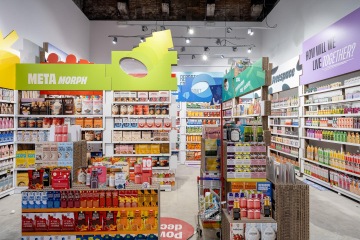
Latvia
TC LATVIJA (TCL)
Curators: Ernests Cerbulis, Uldis Jaunzems-Pëtersons, Ints Meņģelis, Toms Kampars
A thoughtful employment of Lokko’s curation, Latvia’s pavilion communicated ideas of consumption through the use of self-deprecating satire at the Biennale’s expense. The Baltic country’s contribution takes the 506 exhibits from the past 10 Biennales and turns them into items one might find in a supermarket using AI-generated branding—think an exhibition turned into a salad dressing or a 6-pack of beer. Visitors can get creative, mixing and matching “ingredients” (aka exhibits across installments of the bi-annual event) to make their own proverbial thought “salad”, and “checkout” from the market’s employees.
The playful, tongue-in-cheek interpretation of a market poses questions about impact, sustainability, and choice. By reducing the now-built library-of-ideas minted, explored and offered up for consumption across two decades of Biennales into a space where one can pick-and-choose ideas to “consume”, the pavilion reflects on the institution’s own interaction with its purpose for existence. And, with a more critical eye, it uses self-deprecating humor to its advantage by encouraging visitors to examine their own relations to consumption and the results of conformity.
We thought it's worth it to give the ideas second chance, because ideas needs a second chance.
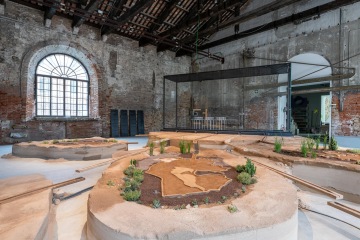
Bahrain
Sweating Assets
Curators: Maryam Aljomairi and Latifa Alkhayat
The Kingdom of Bahrain’s exhibit marries technology, climate change, resource use, and economic security into its pioneering technology that uses condensation collected from AC units to water agricultural plots and replenish wetlands. The technology is a means of adaptive reuse, giving Bahrain the ability to harness a vital and scarce resource in the arid country. Aljomairi and Alkhayat, two recent MIT graduates who won the bid for the pavilion while still completing their degrees, created infrastructure that has the ability to change the future of inhabiting dry landscapes through adaptations in the built environment. They showcase a model of Bahraini land with the infrastructure needed to capture water running into wetlands, replenishing their water supply.
We've estimated that if we were to collect all this water, we would be able to irrigate roughly around 3 million date palm trees per year.
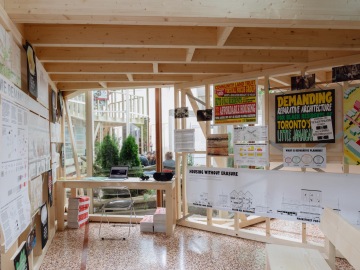
Canada
Not for Sale!!
Curators: Architects Against Housing Alienation (AAHA): Adrian Blackwell, David Fortin, Matthew Soules, Sara Stevens, Patrick Stewart, Tijana Vujosevic
The Canadian pavilion is occupied by the Not for Sale campaign that has issued 10 rather loud demands compiled by architects, housing advocates, and social organizations that outline possible solutions to the housing crisis in Canada. With a specific focus on land repossession for First Nations communities, the curators understand the distinct differences between indigenous and settler housing disparities and aim to address both problems equitably. The pavilion, designed to look like an encampment that features in most North American cities, forces the viewer to grapple with the inequality present in housing, and the reality of the rather-dire situation. The face of oppression and the gritty and heartbreaking reality of living unhoused—especially on land that belonged to indigenous peoples for thousands of years—makes Canada’s pavilion arresting by design-–so in-your-face that you are left cut by the emergency.
(We can) generate kind of new thinking around the housing problems in Canada around the questions of deep decommodification, decolonization, and challenging financialization.
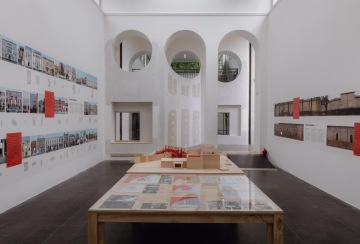
Austria
Partecipazione/Beteiligung
Curators: AKT (Fabian Antosch, Gerhard Flora, Max Hebel, Adrian Judt, Julia Klaus, Lena Kohlmayr, Philipp Krummel, Gudrun Landl, Lukas Lederer, Susanne Mariacher, Christian Mörtl, Philipp Oberthaler, Charlie Rauchs, Helene Schauer, Kathrin Schelling, Philipp Stern and Harald Trapp) and Hermann Czech
The Austrian pavilion explores the deep-routed history of Venice in relation to the Biennale and how diverging philosophies between the event and the city have resulted in public spaces being inaccessible to locals, much to its detriment. The project tackles the ideas of public vs. private land, and the consequences of such distinctions, but places them in a tangible context as it relates to the Biennale and its own colonization of an island already drowning in its own popularity. The initial idea by this year's curators was to build a bridge that would connect their pavilion to an otherwise inaccessible rare slice of green space on the island. The request was rejected, thus the curators elected to build half the bridge anyways as a statement, while exploring the history of the Biennale’s encroachment and impact on the Venetian community.
Ultimately, it serves as a structural and metaphorical reminder that not all design is participatory or inclusive, while connecting to the events deeper themes of colonization and demonstrating its presence on the very ground the exhibition is operating on and its pervasiveness in our shared spaces.
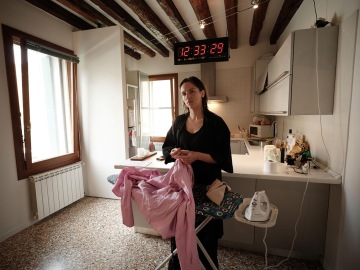
Estonia
Home Stage
Curators: Aet Ader, Mari Möldre, and Arvi Anderson
Estonia’s exhibit purposefully takes place in an apartment in the city, to emphasize the curators objective; to demonstrate the “comforts of home” may be crumbling within the stage of an actual home. The contents of Home Stage involve motifs of spreadsheets, water sculptures, and a live-in actor. The pavilion aims to address the problem of home ownership, as 80% of Estonions own their own home, the curators are interested in highlighting the value and hardship of maintaining property. The exhibit plays on themes of accessibility, value, and class as the idea of younger generations obtaining property is at the forefront.
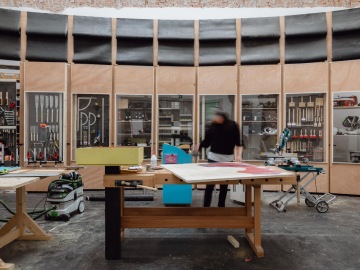
Germany
Open for Maintenance - Wegen Umbau geöffnet
Curators: ARCH+ / SUMMACUMFEMMER / BÜRO JULIANE GREB (Anne Femmer, Franziska Gödicke, Juliane Greb, Christian Hiller, Petter Krag, Melissa Makele, Anh-Linh Ngo, Florian Summa)
Germany’s pavilion directly responds to Lokko’s Laboratory of the Future by cataloging and showcasing leftover materials from last year's Art Biennale. Lokko encouraged architects to reuse materials in their final products, Germany took her words literally. The curators explain that they are squatting in the exhibition space to make a visual statement about the sheer waste of building and the Biennale itself. The pavilion includes discussion spaces where participants can discuss how to repurpose these materials to the benefit of our future cities. The materials in the German pavilion are intended to be made into public art installations within the city of Venice to further underscore the positive impacts of reuse.

Tropical Modernism: Architecture and Power in West Africa
Curators: Dr. Christopher Turner (V&A), Nana Biamah-Ofosu, and Bushra Mohamed (AA)
Applied Arts Pavilion offers a conversation about settlers and power in West Africa reflected in the architectural change at the advent of colonization. A form of reclamation of African identity in the post-colonial world, Tropical Modernism explores the thread of European design that shapes contemporary architecture but in a way of pushing forward the people. The pavilion includes photographs, building plans, and a brise soleil, to reflect the way many African buildings keep out the sun.
A 28-minute video covers key colonial-style buildings that remain in Ghana and shaped new architecture in the region today. The curators believe tropical modernism and the adaptable buildings constructed in the colonial style that adorn West Africa could be a climate responsible form of architecture in hotter regions as the buildings cool effectively. Politics and power negatively affected much of Africa as the continent was cut up by European actors jostling for control, but in the communities, the spirit of the people remained and even as the scars of colonialism touch all of Africa, the indigenous cultures can shine architecturally, even with the reclamation of colonial themes.
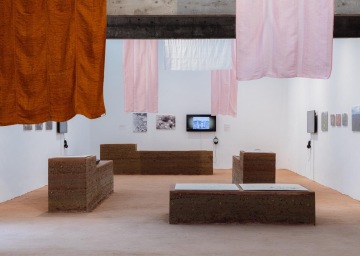
Brazil
Terra [Earth]
Curators: Gabriela de Matos and Paulo Tavares
This year’s winner of the 2023 Golden Lion, the Brazilian pavilion is a masterclass in showcasing national identity, indigeneity, local materials, and political and colonial conversations, that expand beyond the architectural landscape of Brazil. The curators along with their co-designers featured indigenous groups and artisans to center their discussion on earth. Literally, the pavilion features packed dirt that connects the Biennale with the land of Brazil. The curators say “by immersing the public in this environment, we hope to foster a deeper appreciation for the wisdom embedded in these [indigenous] cultural practices.” The African, European, Indigenous, and contemporary influences that are blended in the Brazilian landscape are all represented in the pavilion that asks the visitor to examine their connection to the earth and their place of origin in the face of climate change and decolonization.
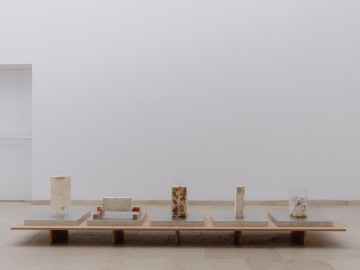
Belgium
In Vivo
Curators: Bento and Vinciane Despret
Belgium’s pavilion explores the contact between resources and life in the constantly changing composition of society. While the world grapples with how to build with the climate in mind, how to use renewable materials, and how to still create within aesthetic narratives, the curators pose a solution. Living materials, like mycelium, or mushrooms, create a facade that showcases the potential of what building with renewable and climate conscious materials looks like. The wooden structure is specifically constructed to be dismantled and repurposed post-Biennale, a theme many exhibitors have embraced during this years’ proceedings—the ability to change and reuse.
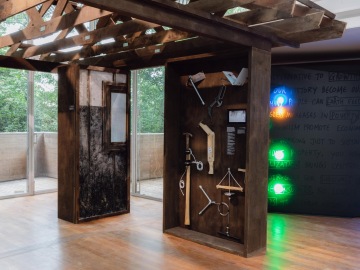
Korea
2086: Together How?
Curators: Soil Jung and Kyong Park
In a future we are uncertain of, the Korean pavilion imagines an ecocultural revolution that would transform the anthropocene. The curators engage visitors, asking how they would work together as climate crises increase, specifically through a game show format where the visitors can “choose their own adventure.” The UN projects that 2086 will be the peak of human population, before it begins to decline as the carrying capacity of the world ecosystem is overloaded. The curators acknowledge the limited resources we enjoy and how the influences of colonialism, westernization, industrialization, and apathy can change our future and our relationship to the natural world. Aiming to create a more balanced life, where humanity can live in harmony with the climate, the Korean pavilion is a forthright view into how we can work together to achieve the future we desire.

Nordic Countries
Girjegumpi: The Sámi Architecture Library
Curators: Carlos Mínguez Carrasco, James Taylor-Foster (ArkDes), and Joar NangoIn this year's edition, the Nordic Countries Pavilion, representing Finland, Norway, and Sweden, unveils an exhibition featuring Girjegumpi—a literary archive that encompasses an expanding collection of over 500 rare titles and contemporary books celebrating Sámi architecture. This collection delves into the indigenous Sámi culture and their unique building practices, as the Sámi people have been inhabitants of northern Scandinavia for millennia. Sámi architecture is influenced by the historically nomadic lifestyle and is inherently climate resilient, imparting valuable knowledge found in many indigenous building practices.
Spearheaded by architect and artist Joar Nango, this collective library project explores the fusion of traditional ways of life with the modern era. The Sámi language and culture was periodically persecuted by the Nordic countries, this library is a way of preserving the touchstones that have faded due to this oppression. Over a span of fifteen years, Nango has diligently compiled an assortment of books and materials that delve into Indigenous Sámi architecture and design, traditional construction knowledge, activism, and the pursuit of decolonization. The beautifully designed pavilion features a gumpi, a traditional Sámi portable building, along with found items, furs, and textiles all indigenous to the Sámi. Nango hopes Girjegumpi helps Europeans to reflect on their colonial history.
